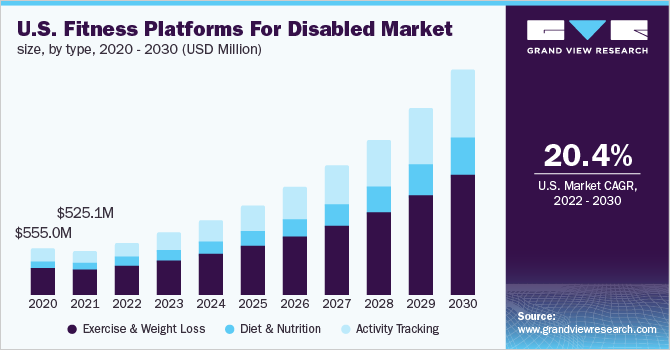Fitness Platforms for Disabled Market Demand, and Business Prospects 2030
Fitness Platforms For Disabled Industry Overview
The global fitness platforms for disabled market size was valued at USD 1.9 billion in 2021 and is expected to expand at a compound annual growth rate (CAGR) of 21.9% from 2022 to 2030.
A transition from traditional studios and gyms to a virtual fitness trend among the general population and people with disabilities has been witnessed during the COVID-19 pandemic. This, in turn, has increased downloads and usage of fitness live streaming platforms. According to the World Economic Forum, in 2020, the global subscriptions of fitness and health platforms increased by 50.0% among the disabled group. This, in turn, increased the usage rate of fitness platforms.
Gather more insights about the market drivers, restrains and growth of the Global Fitness Platforms For Disabled Market

Moreover, the growing trend of online fitness training among people with various disability types, including difficulties in hearing, vision, mobility, and many other functions, is driving the market. Increasing awareness regarding health and wellness among the disabled population is also driving the market. Moreover, the prevalence of disability is rising and is estimated to affect over 15.0% of the global population according to a report published by the WHO in 2020. Conflict and poverty are the two key factors responsible for high rates of disability in developing countries. The prevalence of disability is continuously increasing in the industrialized sectors with the aging population.
In 2019, as per an annual survey conducted by the U.S. Census Bureau under American Community Survey (ACS), nearly 12.8% of the U.S. population in 2019 is anticipated to be registered under people with disabilities. In addition, Europe constitutes about 39.0 million disabled people in 2019 as reported by CSR Europe, wherein Britain accounts for approximately 11.0 million disabled people. However, Saudi Arabia registered the lowest rates of disability prevalence globally, which is 8.0%. In addition, Asian countries are witnessing a high incidence of disability and account for the highest number of prevalent populations estimated above 135.0 million people with disability in 2019.
Additionally, the growing geriatric population has been one of the key reasons behind the increasing prevalence of disability. For instance, the aging U.S. population has led to an increase in the prevalence of people with disabilities. In 2016, the U.S. accounted for less than 1.0% of the population under 5 years with a disability. Likewise, for individuals aged 5 to 17 years, the prevalence rate for disability was valued at 5.6%. Moreover, for people aged 18 to 64 years, the prevalence rate was registered to be nearly 10.6%, and it is 35.2% in people aged 65 years and older. In addition, as per the CDC estimates, nearly 61.0 million adults in the U.S. had disabilities in 2021. This has pushed tech giants, such as Google, Apple, and Microsoft, to launch products and services that are more accessible to this target population.
Moreover, the high economic spending power of the disability community is responsible for the revenue growth in the market. The global disability purchasing market was valued at approximately USD 8.0 trillion in 2020, depicting that PWDs control a significant amount in spending. PWDs and their families, along with friends, represent nearly 73.0% of the consumers who are critical in making purchasing decisions. As per a report—A Hidden Market: The Purchasing Power of People With Disabilities—published by the American Institutes for Research (AIR), about 64.0 million people in the U.S. were registered with at least one disability, and nearly 35.0% of this population comprised people of working age, aged 16 to 65 years, who are earning income via direct employment or additional support and benefits.
The rapid adoption of live streaming platforms in the healthcare sector is one of the key factors driving the adoption of fitness platforms among the disabled population. A 2016 study published in Journal on Technology and Persons with Disabilities revealed that nearly 84.0% of disabled people use or own a smartphone, with 91.0% of users adopting a tablet. In addition, as per the GSMA’s Mobile Disability Gap Report 2020, it has been revealed that smartphones have embedded accessibility and compliant features, including voice command, screen-readers, and magnification, which makes it easier to use for people with hearing or visual disabilities.
Browse through Grand View Research's Healthcare IT Industry Research Reports.
- Move To Earn Fitness Apps Market - The global move to earn fitness apps market size was valued at USD 391.7 million in 2021 and is projected to grow at a CAGR of 18.3% during the forecast period.
- Fitness Tracker Market - The global fitness tracker market size to be valued at USD 138.7 billion by 2028 and is expected to grow at a compound annual growth rate (CAGR) of 18.9% during the forecast period.
Market Share Insights
- September 2021: Move United, a community-based adaptive sports organization, announced the launch of Move United on Demand—a digital fitness platform that offers exercise and fitness routines for disabled communities.
- May 2019: Future Fitness announced that it has received USD 8.5 million in Series A funding led by Kleiner Perkins, an American venture capital firm.
Key Companies profiled:
Some prominent players in the global fitness platforms for disabled market include
- Apple, Inc.
- Kakana
- Champion’s Rx
- Adaptive Yoga Live
- Evolve21
- Kym Nonstop
- Exercise Buddy, LLC
- Special Olympics
- YouTube
- Hulu, LLC
Order a free sample PDF of the Fitness Platforms For Disabled Market Intelligence Study, published by Grand View Research.
Comments
Post a Comment